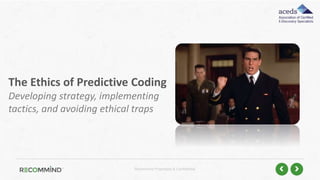The Ethics of Predictive Coding
- 1. Recommind Proprietary & Confidential The Ethics of Predictive Coding Developing strategy, implementing tactics, and avoiding ethical traps
- 2. ACEDS Membership Benefits Training, Resources and Networking for the E-Discovery Community Join Today! aceds.org/join Exclusive News and Analysis Weekly Web Seminars Podcasts On-Demand Training Networking Resources Jobs Board & Career Center bits + bytes Newsletter CEDS Certification And Much More! ŌĆ£ACEDS provides an excellent, much needed forum to train, network and stay current on critical information.ŌĆØ Kimarie Stratos, General Counsel, Memorial Health Systems, Ft. Lauderdale
- 4. Recommind Proprietary & Confidential Speakers Philip Favro Senior Discovery Counsel Recommind, Inc. Gareth Evans Litigation Partner Gibson, Dunn & Crutcher Stacey Blaustein Corporate Litigation Counsel International Business Machines, Inc.
- 5. Recommind Proprietary & Confidential 2 1 3 4 5 What is Predictive Coding? Strategy and Tactics Ethical Traps Defensibility Resources / Q & A Agenda
- 6. Recommind Proprietary & Confidential ŌĆó DOJ has sued Acme Corp. under the False Claims Act for $2.5 billion in damages ŌĆó DOJ is seeking responsive ESI from a universe of 20 million Acme documents ŌĆó Acme is looking at various options to expedite its production of responsive ESI to DOJ, including the use of predictive coding Hypothetical
- 7. Recommind Proprietary & Confidential What is Predictive Coding?
- 8. Recommind Proprietary & Confidential Judicial Definition of Predictive Coding ŌĆ£Under predictive coding, the software ŌĆślearnsŌĆÖ a user's preferences or goals; as it learns, the software identifies with greater accuracy just which items the user wants, whether it be a song, a product, or a search topic.ŌĆØ In re Biomet, 2013 U.S. Dist. LEXIS 84440,*3 (N.D. Ind. Mar. 25, 2013)
- 9. Recommind Proprietary & Confidential Another Court Definition of Predictive Coding ŌĆ£Through iterative learning, these methods (known as ŌĆścomputer-assistedŌĆÖ or ŌĆśpredictiveŌĆÖ coding) allow humans to teach computers what documents are and are not responsive to a particular FOIA or discovery request and they can significantly increase the effectiveness and efficiency of searches. ŌĆØ Nat'l Day Laborer Org. Network v. United States Immigration & Customs Enforcement Agency, 877 F. Supp. 2d 87, 109 (S.D.N.Y., 2012)
- 10. Recommind Proprietary & Confidential Strategy and Tactics
- 11. Recommind Proprietary & Confidential To Disclose or Not To Disclose? How many of you agree with the following statement? ŌĆ£Advise opposing counsel that you plan to use computer-assisted coding and seek agreement; if you cannot, consider whether to abandon predictive coding for that case or go to the court for advance approval.ŌĆØ Da Silva Moore v. Publicis Groupe, 287 F.R.D. 182, 184 (S.D.N.Y. 2013)
- 12. Recommind Proprietary & Confidential ŌĆó Will the training set be randomly selected, targeted, or a hybrid of both? ŌĆó Will opposing counsel be allowed to help develop the training set? ŌĆó How will you address the disclosure of non-responsive and privileged materials in the training set? How Will The ŌĆ£Seed SetŌĆØ Be Handled?
- 13. Recommind Proprietary & Confidential No Obligation to Disclose Non-Responsive Documents In re Biomet, 2013 U.S. Dist. LEXIS 172570, *3 (N.D. Ind. Aug. 21, 2013) ŌĆ£The Steering Committee wants the whole seed set Biomet used for the algorithm's initial training. That request reaches well beyond the scope of any permissible discovery by seeking irrelevant or privileged documents used to tell the algorithm what not to find.ŌĆØ
- 14. Recommind Proprietary & Confidential Other Key Considerations ŌĆó Will discovery be staged? ŌĆó How to accurately determine prevalence? ŌĆó Will clearly non-responsive ESI be removed before training the predictive coding tool? ŌĆó What score assigned to a particular document will be the production cut-off point? ŌĆó How are you handling privilege reviews? ŌĆó What is your validation process?
- 15. Recommind Proprietary & Confidential Ethical Traps
- 16. Recommind Proprietary & Confidential ŌĆó Safeguarding Work Product ŌĆó Protecting Privileged Materials ŌĆó Satisfying the Rule 26(g) Certification Common Ethics Traps Associated with Predictive Coding
- 17. Recommind Proprietary & Confidential ŌĆ£The Steering Committee wants to know, not whether a document exists or where it is, but rather how Biomet used certain documents before disclosing them. Rule 26(b)(1) doesn't make such information disclosable. The only authority the Steering Committee cites is a report of the Sedona Conference . . .ŌĆØ No Obligation to Disclose Opinion Work Product In re Biomet, 2013 U.S. Dist. LEXIS 172570, *4 (N.D. Ind. Aug. 21, 2013)
- 18. Recommind Proprietary & Confidential ŌĆó Should privileged materials be culled from the universe of potentially responsive ESI? ŌĆó How can the privilege be protected if a negotiated protocol requires privileged materials be included in the seed set? ŌĆó What search methods and quality control measures are in place to identify privileged materials before production? ŌĆó Is there a Rule 502(d) order in place? Implementing Privilege Safeguards in the Review Process
- 19. Recommind Proprietary & Confidential ŌĆó Must you disclose the use of predictive coding and/or enter into a stipulated protocol to comply with Rule 26(g)(1)(B)? ŌĆó If you fail to do so, could you be precluded from using predictive coding? Satisfying the Rule 26(g) Reasonable Inquiry Standard Progressive v. Delaney, 2014 U.S. Dist. LEXIS 69166 (D. Nev. May 19, 2014)
- 20. Recommind Proprietary & Confidential Defensibility
- 21. Recommind Proprietary & Confidential ŌĆó Have a well-documented process ŌĆó Demonstrate that the process is reasonable; perfection not required ŌĆó Consider whether to disclose PC use; agreements on front-end might be beneficial, but could still be problematic Defending the Process
- 22. Recommind Proprietary & Confidential Resources / Q & A
- 23. Recommind Proprietary & Confidential Resources Hon. Patrick J. Walsh, Rethinking Civil Litigation in Federal District Court, 40 LITIG. 6, 7 (2013) Dana A. Remus, The Uncertain Promise of Predictive Coding, 99 Iowa L. Rev. 1691 (2014)
- 24. Recommind Proprietary & Confidential RESOURCES http://www.recommind.com/mind-over-matters
- 25. Recommind Proprietary & Confidential 25 Q & A
- 26. Recommind Proprietary & Confidential 26 Thank you!! Philip J. Favro Senior Discovery Counsel phil.favro@recommind.com (650) 714-9134


























